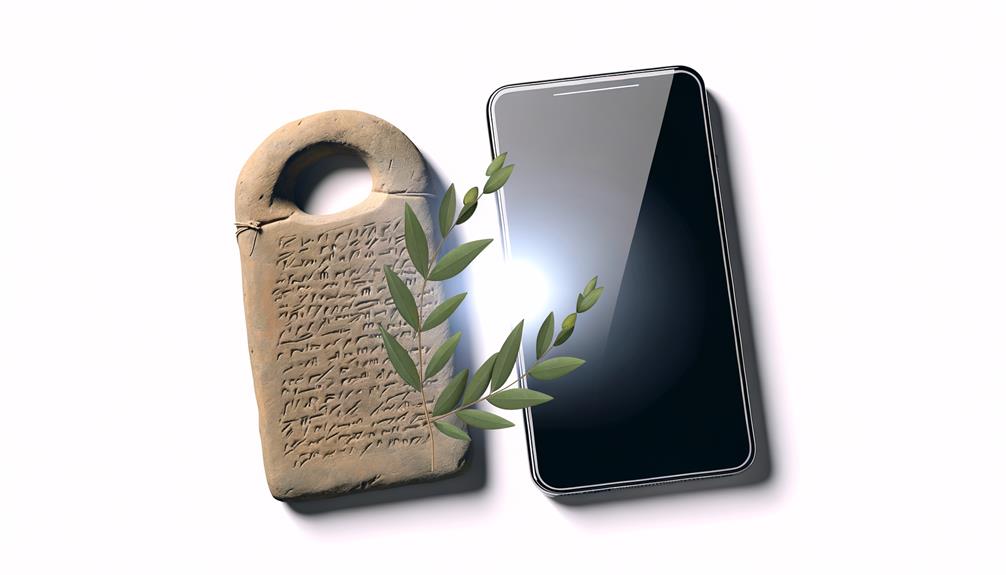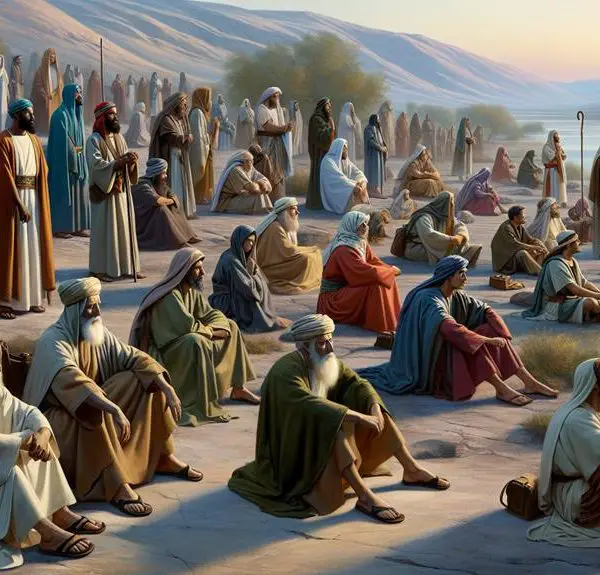Peeling back the layers of 'Ezer Kenegdo' reveals profound insights into biblical notions of partnership and equality, inviting a deeper exploration.

Ezer Kenegdo in the Bible
In the tapestry of biblical texts, the term 'Ezer Kenegdo' emerges as a thread of intrigue and complexity, woven into the Genesis narrative with profound implications.
You've likely encountered various translations and interpretations, each layering different shades of meaning onto this enigmatic phrase. Historically, scholars and theologians have grappled with its implications for gender roles, partnership, and divine intention.
But what does it truly signify in the context of the Genesis creation story, and how has its understanding evolved in contemporary discussions? The exploration of this term not only unlocks ancient perspectives but also challenges modern viewpoints on partnership and equality.
Now, let's peel back the layers together and uncover the rich insights 'Ezer Kenegdo' offers.
Key Takeaways
- Ezer Kenegdo signifies a partnership model emphasizing equality and mutual support between genders in biblical context.
- The term embodies both powerful assistance and complementarity, underscoring the importance of balanced relationships.
- Interpretations of Ezer Kenegdo have evolved, reflecting changing views on gender roles and equality through history.
- Contemporary discussions on Ezer Kenegdo advocate for reevaluating traditional gender roles, promoting an egalitarian partnership model.
Origins of Ezer Kenegdo

The term 'Ezer Kenegdo' originates from the Hebrew Bible, specifically within the creation narratives of Genesis, where it describes the intended role and nature of Eve as a companion and counterpart to Adam. This phrase is pivotal in understanding the theological and sociological underpinnings of human relationships as envisioned in the earliest Judeo-Christian texts. Delving into its Hebrew etymology sheds light on the nuanced meanings that have been debated among scholars and theologians for centuries.
'Ezer', derived from the Hebrew, implies 'help' or 'assistance,' yet this is no ordinary help. It conveys a sense of powerful support, often used in contexts where God provides critical aid to humans. Thus, the term elevates the role attributed to Eve, suggesting a form of help that's indispensable and empowering, rather than subordinate or ancillary.
'Kenegdo', on the other hand, combines the preposition 'ke', meaning 'as' or 'like,' with 'neged', which translates to 'opposite' or 'counterpart.' This component of the phrase emphasizes a relationship of equality and complementarity. Eve is portrayed not as a subordinate being but as a counterbalance to Adam, an equal partner with a distinct, yet complementary, role in the creation narrative.
Analyzing 'Ezer Kenegdo' through the lens of Hebrew etymology and its context within the Genesis creation narratives, you're drawn into a deeper understanding of its implications. It suggests a model of partnership where both individuals are essential, bringing unique strengths and perspectives to the relationship. This concept, rooted in the ancient texts, continues to inspire contemporary discussions on gender, partnership, and the nature of support within human relationships.
Translating Ezer Kenegdo

Frequently, translating 'Ezer Kenegdo' from Hebrew into English, or any language, presents a complex challenge, as you must navigate both the depth of its original context and the nuances of linguistic interpretation. This phrase, deeply embedded in Judeo-Christian theology, carries significant implications. A meticulous linguistic analysis reveals that 'ezer' connotes 'help' but not in a subordinate sense; rather, it implies a form of assistance that's essential and powerful, often used in contexts describing divine intervention. 'Kenegdo', on the other hand, suggests a notion of correspondence and equality, positioning the helper as directly opposite or facing the one being helped, implying a partnership of equals.
Understanding this partnership through the cultural context is crucial. The original audience would have perceived 'Ezer Kenegdo' within a patriarchal society, yet the term itself suggests a subversion of purely hierarchical structures, indicating a complementary relationship. This nuance is often lost or oversimplified in translation, leading to interpretations that either diminish the strength of 'ezer' or misunderstand the equality implied by 'kenegdo'.
Thus, when you dive into the task of translating 'Ezer Kenegdo,' you're not just converting words from one language to another; you're interpreting centuries of theological, cultural, and linguistic layers. Your aim should be to preserve the richness of the original, acknowledging that each translation is, to some extent, an interpretation. Given the depth and complexity of these terms, a translator must approach this task with sensitivity to both linguistic precision and the broader cultural and theological implications.
Historical Interpretations

Throughout history, scholars have debated the interpretation of 'Ezer Kenegdo,' offering diverse perspectives that reflect the evolving understanding of gender roles and partnership. Your exploration into this matter reveals how deeply cultural influences and rabbinic commentary have shaped interpretations over centuries. As you delve deeper, consider these key historical interpretations:
- Early Rabbinic Commentary: Early Jewish scholars viewed 'Ezer Kenegdo' as denoting a partnership of equals, emphasizing support and companionship. This interpretation, deeply rooted in the culture of ancient Israel, shows an early recognition of the nuanced dynamics between partners.
- Medieval Perspectives: During the medieval period, interpretations began to reflect the patriarchal values of the time. 'Ezer Kenegdo' was often seen through the lens of helper or supporter, with a slightly subordinate connotation, highlighting the shifting cultural attitudes towards gender roles.
- Renaissance Reinterpretations: The Renaissance brought about a revival in the study of ancient texts, including the Bible. Scholars of this era started to question previous interpretations of 'Ezer Kenegdo,' often returning to the concept of equality and mutual support within the partnership, influenced by the humanistic values of the period.
- Modern Examination: In recent times, there's been a resurgence in exploring the original context and meaning of 'Ezer Kenegdo,' driven by contemporary discussions on gender equality. Modern scholars tend to emphasize the egalitarian aspects of the term, reflecting current cultural shifts towards recognizing gender parity.
Your journey through the historical interpretations of 'Ezer Kenegdo' unveils how cultural shifts and rabbinic commentary have intricately woven together to shape our understanding of this biblical concept, highlighting the complexity of interpreting ancient texts in changing times.
Gender Roles and Ezer Kenegdo
Having explored the historical interpretations of 'Ezer Kenegdo,' let's now examine its implications on gender roles within biblical contexts, highlighting how this concept shapes our understanding of partnership and equality. The term itself, often translated as "helper suitable for him," carries a weight of meaning that has evolved over time, deeply influenced by both feminist perspectives and cultural influences.
Aspect |
Implications on Gender Roles |
|---|---|
Feminist Perspectives |
These views challenge traditional interpretations, suggesting 'Ezer Kenegdo' implies a partnership of equals, rather than a hierarchical structure with men at the top. |
Cultural Influences |
Over time, societal changes have influenced how 'Ezer Kenegdo' is understood, with modern interpretations often reflecting more egalitarian views of gender roles. |
Biblical Context |
Within the narrative of Genesis, 'Ezer Kenegdo' sets a precedent for considering women and men as complementary partners, each playing a crucial role in God's creation. |
This table illustrates the multifaceted approach to understanding 'Ezer Kenegdo' and its impact on gender roles. By dissecting feminist perspectives, you see a push towards recognizing the inherent equality and partnership depicted in the biblical narrative. Meanwhile, cultural influences have undeniably shaped and sometimes skewed these interpretations, often reflecting the prevailing attitudes towards gender of the times.
In essence, 'Ezer Kenegdo' serves as a foundational concept for rethinking gender roles within a biblical framework. It encourages a dialogue that respects the complexity and dynamism of human relationships, advocating for a partnership model rooted in equality and mutual support. This analytical journey sheds light on the transformative potential of biblical texts in addressing contemporary issues of gender and partnership.
Ezer Kenegdo in Theology

You'll find that the term 'Ezer Kenegdo' offers a complex layer of meaning within theological discourse, especially when examining its implications on gender roles.
Scholars interpret this phrase as denoting both a helper and counterpart, suggesting a nuanced understanding of partnership that challenges traditional gender norms.
This interpretation significantly impacts theological discussions on equality and complementarity in relationships, providing a fertile ground for reevaluating biblical gender roles.
Meaning and Interpretation
Why does the term 'Ezer Kenegdo,' found within the theological context of the Bible, spark such diverse interpretations among scholars? It's a topic that dives deep into:
- The cultural context of ancient times, which shapes our understanding of the term.
- Linguistic nuances that are often lost or transformed in translation.
- The evolving nature of language and how meanings shift over centuries.
- How theological perspectives influence the interpretation of biblical terms.
Analyzing 'Ezer Kenegdo' requires a careful examination of these elements. Scholars must navigate through the cultural and linguistic layers to uncover the term's original intent and significance. This process is intricate, as it involves piecing together historical, linguistic, and theological insights to achieve a comprehensive understanding.
Impact on Gender Roles
Exploring the term 'Ezer Kenegdo' further, we uncover its profound implications for understanding gender roles within theological discourse. Feminist theology particularly leverages this term, asserting that traditional interpretations have often reinforced patriarchal structures, rather than the partnership and equality suggested by 'Ezer Kenegdo'. This insight challenges and reshapes our understanding of gender roles as mere social constructs within religious contexts.
Aspect |
Impact |
|---|---|
Interpretation |
Calls for a reevaluation of traditional gender roles |
Feminist Theology |
Emphasizes equality and partnership |
Social Constructs |
Questions the origins of gender roles |
Biblical Texts |
Provides a foundation for progressive interpretations |
Theological Discourse |
Encourages a more inclusive understanding |
This analytical approach encourages a deeper contemplation of how we engage with sacred texts and their implications for gender dynamics today.
Contemporary Relevance

You'll find that the concept of Ezer Kenegdo provides profound insights into gender equality, challenging traditional interpretations and suggesting a partnership model that's inherently egalitarian.
This perspective reshapes our understanding of modern marital dynamics, advocating for a balance of power and responsibilities between partners.
Gender Equality Insights
The term 'Ezer Kenegdo,' originating from the Bible, offers profound insights into contemporary discussions on gender equality, highlighting its historical depth and evolving interpretations. This phrase has been a focal point in feminist theology and scrutinized within various cultural contexts. Here's how it contributes to our understanding:
- Feminist Theology: It challenges traditional narratives, advocating for a more egalitarian view of gender roles.
- Cultural Contexts: Interpretations vary widely, reflecting diverse societal norms and values.
- Historical Depth: Enables a richer understanding of gender roles over millennia.
- Evolving Interpretations: Shows how perceptions of gender equality have shifted, inviting ongoing dialogue.
This exploration underscores the complexity and richness of the discourse on gender equality, rooted in ancient texts but highly relevant today.
Modern Marital Dynamics
In contemporary discussions on marital dynamics, 'Ezer Kenegdo' serves as a pivotal reference, revealing shifts towards more equitable partnerships between spouses. This ancient concept, once rooted in hierarchical structures, now underscores the evolving cultural norms that advocate for mutual respect and support within marriages.
Experts in relationship advice draw upon 'Ezer Kenegdo' to highlight the importance of viewing partners as equals, each contributing uniquely to the relationship's success. This perspective challenges traditional roles, encouraging couples to negotiate responsibilities based on strengths, rather than societal expectations.
As a result, marriages are increasingly seen as partnerships where both individuals thrive, reflecting a deeper understanding of 'Ezer Kenegdo' in light of modern values and aspirations.
Biblical Partnerships

Exploring biblical partnerships reveals a complex tapestry of relationships designed to reflect divine intentions and human interactions. Within this framework, divine partnerships and spiritual companionship stand out as foundational principles, offering profound insights into the nature and purpose of human connections. These relationships aren't merely historical or anecdotal; they're emblematic of broader theological and existential themes that transcend time and culture.
Consider these aspects of biblical partnerships:
- Mutual Support: Biblical narratives frequently emphasize the mutual support partners offer each other. This support isn't just physical or emotional but deeply spiritual, reflecting a shared commitment to God's purposes and each other's well-being.
- Complementary Roles: The concept of partnerships in the Bible often involves complementary roles. These roles aren't about hierarchy or superiority but about fulfilling the divine design where each partner's strengths counterbalance the other's weaknesses, creating a harmonious whole.
- Covenantal Connections: Many biblical partnerships are framed within the context of a covenant, highlighting the seriousness and sanctity of these relationships. This covenantal aspect underscores the commitment to faithfulness, loyalty, and mutual respect, mirroring the covenant between God and His people.
- Spiritual Growth: Through these partnerships, individuals experience spiritual growth and development. The interactions and challenges faced within these relationships serve as catalysts for deeper faith, understanding, and closeness to God.
Biblical partnerships, thus, aren't merely historical records but exemplars of divine partnerships and spiritual companionship, offering timeless insights into how relationships can mirror divine love and purpose.
Ezer Kenegdo in Modern Discussions

Diving into modern discussions, it's crucial to understand how the term 'Ezer Kenegdo,' traditionally interpreted within biblical scholarship, has evolved to reflect contemporary perspectives on partnership and gender roles. You'll find that feminist perspectives have significantly influenced this evolution, challenging long-standing interpretations and advocating for a reading that highlights equality and mutual support between partners. This shift isn't just academic; it resonates deeply with broader cultural shifts toward gender equality and reevaluation of traditional roles.
Feminist theologians argue that 'Ezer Kenegdo' implies a partner of equal strength and worth, not a subordinate helper. This interpretation disrupts conventional patriarchal readings, suggesting instead that the original biblical text supports a more egalitarian view of gender relations. Such insights have fueled debates and discussions, pushing scholars and believers alike to rethink assumptions about biblical narratives and their implications for modern gender roles.
Moreover, as cultural shifts continue to challenge rigid gender binaries, the term 'Ezer Kenegdo' becomes a focal point for discussions around partnership that transcends traditional male-female dynamics. This reevaluation embraces a broader understanding of partnership as encompassing mutual respect, support, and equality, irrespective of gender.
In essence, the modern discourse around 'Ezer Kenegdo' reflects a growing consensus towards interpreting biblical texts in a way that aligns with contemporary values of equality and partnership. It's a testament to how ancient texts can find new life and relevance in the light of evolving societal norms, offering fresh perspectives on timeless themes of companionship, support, and mutual respect.
Frequently Asked Questions
How Has the Concept of Ezer Kenegdo Influenced Modern Legal Systems and Their Approach to Marriage and Partnership Rights?
You've likely noticed how modern legal systems have evolved in their approach to marriage and partnership rights. This shift has been significantly influenced by the push for gender equality. Legal reforms have taken center stage, ensuring that laws governing partnerships mirror these values.
Are There Any Significant Cultural Festivals or Traditions That Have Been Inspired by the Idea of Ezer Kenegdo Across Different Societies?
You're diving into the rich tapestry of cultural interpretations, particularly how traditions are shaped.
Imagine a festival, rooted deeply in the concept of partnership and support, mirroring the essence of ezer kenegdo. This isn't just about celebration; it's a profound reflection of societal values.
Analyzing festival origins, you uncover layers of meaning, showing how ancient principles influence contemporary practices, weaving a detailed narrative that connects past beliefs with present-day commemorations.
How Do Non-Abrahamic Religions Interpret or Have Equivalents to the Concept of Ezer Kenegdo, and What Are the Similarities or Differences?
When you explore non-Abrahamic religions, you'll find Hindu parallels and Taoist interpretations that mirror the concept of a supportive partner.
In Hinduism, the idea of Shakti and Shiva reflects a dynamic balance, echoing the supportive partnership.
Meanwhile, Taoist philosophy emphasizes yin and yang harmony, akin to the mutual support found in the concept you're asking about.
Both examples highlight the universal theme of balanced partnerships across diverse cultures.
Can the Concept of Ezer Kenegdo Be Related to Psychological Models of Companionship and Support in Contemporary Mental Health Studies?
You're diving deep into the dynamics of companionship and support, exploring if contemporary psychological models like Attachment Theory and Resilience Research can relate to the concept of a supportive partner.
This analysis isn't just academic; it's about understanding how deep bonds and resilient support systems mirror ancient notions of partnership.
Your investigation bridges historical texts and modern mental health, offering a nuanced view of how we connect and support each other today.
In What Ways Have Artists, Musicians, and Writers Incorporated the Theme of Ezer Kenegdo Into Their Works, and What Impact Has It Had on Popular Culture?
You've seen how musical interpretations and literary motifs weave the theme of companionship and support into the fabric of pop culture. Artists, musicians, and writers draw on this concept to explore relationships and human connection, impacting audiences profoundly. Their works resonate with many, sparking discussions and reflections on the essence of partnership.
This creative exploration enriches our understanding of companionship, leaving a lasting imprint on popular culture's narrative landscape.
Conclusion
In exploring ezer kenegdo, you've journeyed through ancient texts, unveiling layers of translation and interpretation that have shaped understandings of gender roles and partnerships across millennia.
You've analyzed the term's theological roots and its contemporary resonance, discovering its enduring relevance in modern dialogues. This exploration underscores the complexity and richness of biblical partnerships, challenging us to rethink traditional narratives.
As you reflect on ezer kenegdo, consider its profound implications for equality and companionship in both ancient and modern contexts.



Sign up